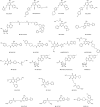International Union of Basic and Clinical Pharmacology. CXII: Adenosine Receptors: A Further Update
- PMID: 35302044
- PMCID: PMC8973513
- DOI: 10.1124/pharmrev.121.000445
International Union of Basic and Clinical Pharmacology. CXII: Adenosine Receptors: A Further Update
Abstract
Our previous International Union of Basic and Clinical Pharmacology report on the nomenclature and classification of adenosine receptors (2011) contained a number of emerging developments with respect to this G protein-coupled receptor subfamily, including protein structure, protein oligomerization, protein diversity, and allosteric modulation by small molecules. Since then, a wealth of new data and results has been added, allowing us to explore novel concepts such as target binding kinetics and biased signaling of adenosine receptors, to examine a multitude of receptor structures and novel ligands, to gauge new pharmacology, and to evaluate clinical trials with adenosine receptor ligands. This review should therefore be considered a further update of our previous reports from 2001 and 2011. SIGNIFICANCE STATEMENT: Adenosine receptors (ARs) are of continuing interest for future treatment of chronic and acute disease conditions, including inflammatory diseases, neurodegenerative afflictions, and cancer. The design of AR agonists ("biased" or not) and antagonists is largely structure based now, thanks to the tremendous progress in AR structural biology. The A2A- and A2BAR appear to modulate the immune response in tumor biology. Many clinical trials for this indication are ongoing, whereas an A2AAR antagonist (istradefylline) has been approved as an anti-Parkinson agent.
U.S. Government work not protected by U.S. copyright.
Figures





References
-
- Abo-Salem OM, Hayallah AM, Bilkei-Gorzo A, Filipek B, Zimmer A, Müller CE (2004) Antinociceptive effects of novel A2B adenosine receptor antagonists. J Pharmacol Exp Ther 308:358–366. - PubMed
-
- Akbari A, Khalili-Fomeshi M, Ashrafpour M, Moghadamnia AA, Ghasemi-Kasman M (2018) Adenosine A2A receptor blockade attenuates spatial memory deficit and extent of demyelination areas in lyolecithin-induced demyelination model. Life Sci 205:63–72. - PubMed
-
- Alberty RA, Hammes GG (1958) Application of the theory of diffusion-controlled reactions to enzyme kinetics. J Phys Chem 62:154–159.
Publication types
MeSH terms
Substances
Grants and funding
LinkOut - more resources
Full Text Sources
Other Literature Sources
Molecular Biology Databases
Research Materials

